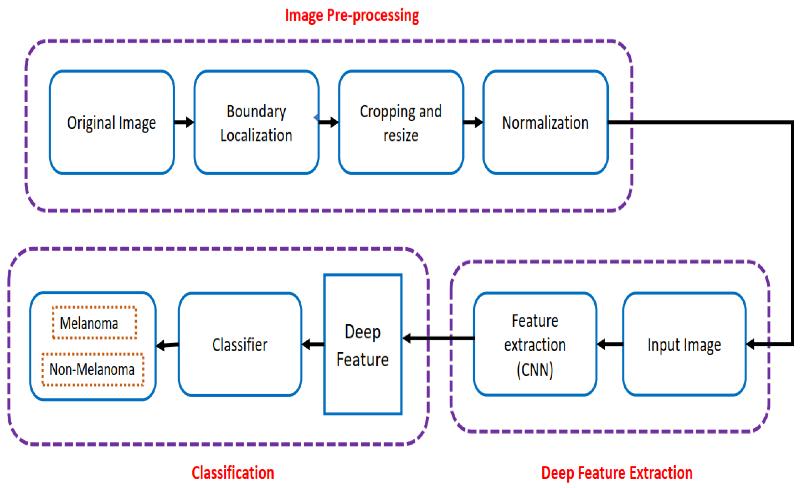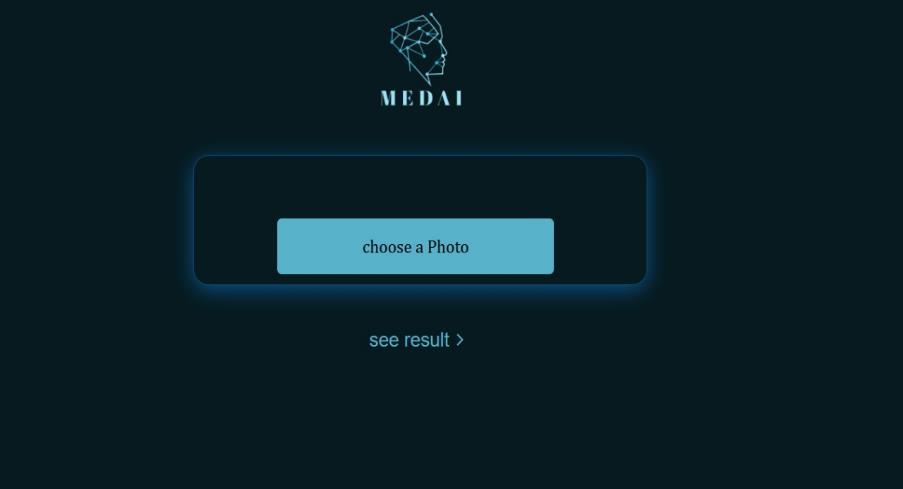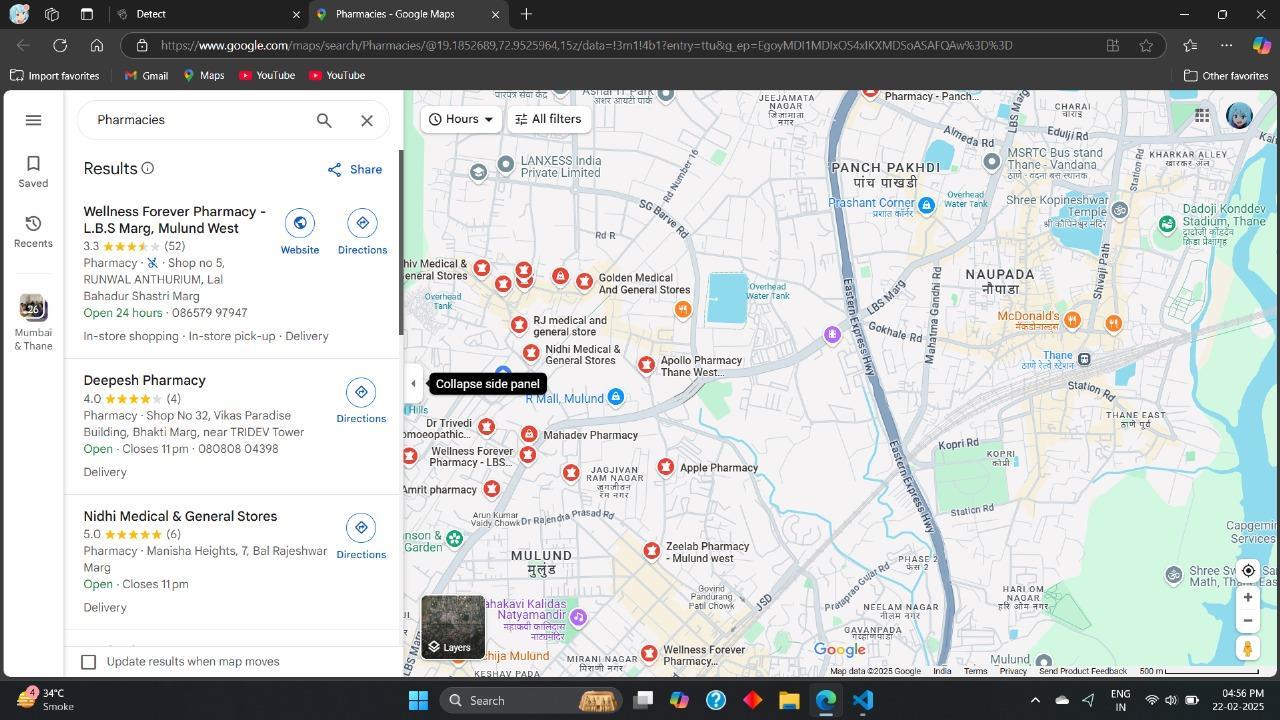
International Research Journal of Engineering and Technology (IRJET) e-ISSN:2395-0056 p-ISSN:2395-0072

Volume:12Issue:04|Apr2025 www.irjet.net


International Research Journal of Engineering and Technology (IRJET) e-ISSN:2395-0056 p-ISSN:2395-0072

Volume:12Issue:04|Apr2025 www.irjet.net
Deepak Bonagiri Department of Information Technology
K.C. College Of Engineering
Aniruddha Keskar
Department of Information Technology
K.C. College Of Engineering
Abstract - Skin diseases pose a significant global health challenge, impacting millions of people across various age groups and populations. Timely detection and precise diagnosis are essential for successful treatment and better patientoutcomes.MedAIisaninnovative,AI-drivensystem that leverages deep learning to classify and diagnose skin diseases withhighprecision.Thisresearchpaper presents a comprehensive exploration of MedAI’s methodology, dataset, model architecture, and performance evaluation. The system shows strong potential in supporting dermatologists, minimizing diagnostic errors, and improving access to dermatological care especially in underserved areas. Additionally, the paper explores the ethical challenges of implementing AI in medical diagnostics,suchasdata privacy,model transparency,and seamless integration with current healthcare systems. By combining cutting-edge technology with a focus on scalabilityandinclusivity
Skin diseases cover a broad range of conditions, from common issues like eczema and acne to serious, potentially fatal illnesses such as melanoma. Accurate diagnosis often requires the expertise of dermatologists, whose availability is limited, especially in remote and underdeveloped areas. The global prevalence of dermatological conditions, coupled with the shortage of specialists, has created an urgent need for scalable, accurate,and accessible diagnostic solutions.MedAI,an AIdriven system powered by deep learning, addresses this challenge by automating skin disease classification and providing treatment recommendations. By leveraging convolutional neural networks (CNNs), MedAI aims to reduce diagnostic errors, improve patient outcomes, and bridge the healthcare accessibility gap. Traditional diagnostic methods rely heavily on manual visual assessments and invasive procedures such as biopsies, which can be time-consuming, costly, and prone to human error. The incorporation of AI into medical imaging has shown impressive promise in automating processesandimproving diagnosticaccuracy.Building on this foundation, MedAI leverages deep learning techniques toclassify skin diseases with both efficiency

Sandesh Ghorpade Department of Information Technology
K.C. College Of Engineering
Asst.Prof. Priyanka Sananse Department of Information Technology
K.C. College Of Engineering
and precision. Thispaper explores the implementation, challenges, and performance of MedAI in real-world scenarios, emphasizing its potential applications in telemedicine and remote healthcare. This project introduces a web-based AI/ML system for skin disease detectionthatallowsuserstouploadimagesofaffectedskin areas. The system uses a trained convolutional neural network (CNN) to analyze the image and detect possible skinconditions in real time. Upon detection, it provides suggested medications, along with nearby clinic informationbasedontheuser’s location. What makes this solution unique is that itoperates without the need for a doctor, making it especially useful for areas with limited healthcarefacilities. The platform is user-friendly, privacy- conscious, and designed to deliver quick and reliable results, thereby promoting early detection, treatmentguidance,andbetterhealthoutcomes.
In 2025, a study published in the International Journal of Research Publication and Reviews explored the use of Convolutional Neural Networks (CNNs) for skin disease detection. The model achieved an impressive 93.5% F1score around multi-class skin disease classification tasks. The system focused on preprocessing techniques such as image normalization and augmentation to improve model accuracy.[1]
A March 2025 paper in Biomedical Signal Processing and Control presented a novel use of transformer-based architectures for skin lesion classification. Unlike CNNs, transformers provided attention-based localization, improving the model’s focus on the actual disease regions..[2]
A 2024 article in the Journal of Engineering and Applied Science proposedadeeplearningframeworkforautomated skin cancer screening using pretrained models like InceptionV3 and ResNet50. The system efficiently differentiated between benign and malignant skin conditionssuchasmelanoma.[3]

International Research Journal of Engineering and Technology (IRJET) e-ISSN:2395-0056 p-ISSN:2395-0072

Volume:12Issue:04|Apr2025 www.irjet.net
In2023,a studyexploredtheintegrationofExplainable AI (XAI) for skin disease classification. This approach used Grad-CAM and Layer-wise Relevance Propagation (LRP) to generate visual maps highlighting the parts of the skin image that influenced the model’s decision. This boosted transparency and user confidence, especially in critical healthcareapplications.[4]
A 2022 research paper focused on applying federated learningtoskindiseasedetectionsystemstomaintainuser privacy.Ratherthancentralizingsensitivemedicaldata,the system trained AI models locally on user devices, only sharingmodelupdates.[5]
A 2021 study tested hybrid models, combining CNNs with machine learning algorithms such as Support Vector Machines (SVM) and Random Forest. The goal was to classifyskinlesionsmoreeffectivelyusingbothdeepimage featuresandstatisticallearning.[6]
In 2020, early developments in AI-powered teledermatology aimed to assist dermatologists and patients in rural regions. These systems enabled users to upload skin images via smartphones, which were then classifiedbybasicCNNmodel.[7]
The methodology for developing a skin disease detection system using machine learning involves a systematic approach that encompasses data collection, preprocessing, modeldevelopment,andevaluation
1.ResearchandAnalysis:
Market Analysis: Conduct a comprehensive analysis of the current digital healthcare and dermatology market, focusing on consumer needs, AI-powered diagnostic tools, and evolvingindustrytrends.Thegrowingdemandforaccessible and remote health services, particularly in rural and underserved regions, highlights a critical gap in dermatologicalcare
2.DesignandPrototyping:
UserPersonaCreation:userpersonasbasedonrealresearch data collected through surveys and interviews. These personas represent key target demographics such as individuals in rural areas with limited access to dermatologists, young adults seeking fast and private skin checks, and elderly users needing easy-to-use, guided interfaces.
3.TechnicalDevelopment:
PlatformSelection:ForthedevelopmentofourAI/ML-based skin disease detection system, we carefully selected a suitable web-based platform that supports real-time image processingandmodeldeployment
4.ImplementationofAIFeatures:

To enhance user value, the system also generates medicine suggestions relevant to the detected condition and displays nearby clinic information based on the user’s location. Additional features include image quality checks, confidence scores,andresultinterpretationaidstoimproveusabilityand trust
5.TestingandValidation:
Functional Testing: The AI/ML model underwent validation to confirm accurate skin disease detection across multiple test cases, including different skin tones and lighting conditions. The medicinesuggestion engine wascheckedfor relevanceandcorrectness.
User Acceptance Testing (UAT): These users tested the system’s full functionality from uploading skin images to receiving disease predictions, medicine suggestions, and nearbyclinicinformation.
6.DeploymentandMarketing:
The deployment process included final security checks, privacy settings, and mobile responsiveness to support diverse user groups. For marketing, we implemented a digital-first strategy targeting social media platforms, health forums,andstudentcommunitiesPost-Launch
7.Post-LaunchEvaluation:
User Analytics Monitoring: To continuously improve the platform,auseranalyticssystemwasintegratedtotrackkey usage metrics such as number of image uploads, time spent on diagnosis, repeat visits, and geographic distribution of users


International Research Journal of Engineering and Technology (IRJET) e-ISSN:2395-0056 p-ISSN:2395-0072

Volume:12Issue:04|Apr2025 www.irjet.net

4.Related Work
The application of AI in dermatology has gained significant traction in recent years, with notable contributions from leading research institutions and technology companies. Google’s DeepDerm and Stanford’s AI-based dermatology classifier have showcased the potential of CNNs in medical image analysis. These systems have demonstrated dermatologist-level performance in classifying skin diseases, highlighting the transformative impact of AI in healthcare. However,challengessuchasdatabias,modelinterpretability, and regulatory compliance remain significant barriers to widespreadadoption.


Fig.signinPage
The login page provides secure access to users of the skin disease detection platform. It includes fields for email/username andpassword, ensuring thatonlyauthorized userscanaccesstheirmedicalhistoryandresults.Thesystem maintains privacy and confidentiality of user-submitted skin images and diagnoses. Features like password recovery and accountcreationareincludedforeaseofuse. Logged-inusers cantracktheirpreviousdiseasereports,medicinesuggestions, and clinic visits. This personalized access improves user experienceanddatasecurity.

Fig. choose image
MedAI extends its capabilities to a broader range of skin conditions, including psoriasis, eczema, and fungal infections A comparative analysis of these architectures reveals the trade-offs between accuracy and computational efficiency, with ResNet50 emerging as a robust choice for medical image analysis due to its residual learning framework and ability to mitigate the vanishinggradientproblem


International Research Journal of Engineering and Technology (IRJET) e-ISSN:2395-0056 p-ISSN:2395-0072

Volume:12Issue:04|Apr2025 www.irjet.net scan and detect image






5.USES
Volume:12Issue:04|Apr2025 www.irjet.net
International Research Journal of Engineering and Technology (IRJET) e-ISSN:2395-0056 p-ISSN:2395-0072


AI is revolutionizing healthcare by enabling faster and more accurate disease diagnosis through image recognition, such as identifying skin diseases, cancers, and eyeconditions..Herearesomecommonusesofai:
1. Education: In the education sector, AI enables personalized learning by adapting to each student's progress and learning style. It streamlines tasks like grading, provides AI-powered tutors and chatbots to answer questions, and predicts student outcomes allowingeducatorstostepinearlywhensupportisneeded.
2. Finance: AI is essential in the finance sector, contributing to fraud detection, algorithmic trading, automated customer service, and credit risk assessment. It examinestransactionpatternstospotsuspiciousbehaviour in real time and delivers personalized financial guidance viavirtualassistants.
3. Agriculture: AI in agriculture supports crop health monitoring, early detection of pests and diseases, optimized irrigation, and yield forecasting. Using drones andsensors,AIgathersfielddata,enablingfarmerstomake informeddecisionsthatboostproductivityandcutcosts.
4. Transportation: AI is transforming transportation by improving safety and efficiency through technologies like self-driving cars and intelligent traffic systems. It predicts traffic flow, optimizes routes, manages vehicle fleets, and powers autonomous navigation to help reduce accidents andeasecongestion.
5. Retail & E-commerce: AI is extensively utilized in retail to deliver personalized shopping experiences, recommend products, manage inventory, and enhance customer service through chatbots. By analysing purchasing patterns and trends, it helps provide more relevant suggestions to customers and improves overall operationalefficiency.
6. CONCLUSION AND FUTURE SCOPE
MedAI represents a significant advancement in AI-driven skin disease classification, offering high accuracy and realtime diagnostic capabilities. The system has the potential to serve as a valuable tool for dermatologists and healthcare providers, particularly in underserved regions. However, furthervalidationinclinicalsettingsisessentialtoensureits reliability and efficacy before widespread adoption. Future improvements include expanding the dataset to cover rare skin diseases, integrating explainability techniques for enhanced transparency, and collaborating with dermatologists. Additionally, the incorporation of federated learning techniques could enhance data security while maintaining model performance across diverse populations.
1. Jahanifar,M.,Rezaeipanah,A.,&Mohsenzadeh,Y.(2023). BiasmitigationindermatologyAImodels:Acomparative evaluationframework. IEEEAccess
2. Goyal, M., Oakley, A., & Pellacani, G. (2022). Skin disease diagnosis using AI: Current status, challenges, and future directions. Journal of the American Academy of Dermatology.
3. Rajkomar,A.,etal.(2022).Machinelearninginmedicine: Addressingethicalandregulatorychallenges. NEJMAI.
4. Mahbod, A., Schaefer, G., Wang, C., et al. (2021). Transfer learningusinga multi-scaleandmulti-network ensemble for skin lesion classification. Computers in Biology and Medicine
5. Anwar, S. M., et al. (2021). Medical image analysis using AI: Deployment architecture and security challenges. JournalofHealthcareEngineering
6. Kaissis,G.A.,etal.(2021).Secure,privacy-preservingand federated machine learning in medical imaging. Nature MachineIntelligence
7. Han,S.S.,Kim,M.S.,Lim,W., etal.(2020).Deeplearning approaches for the detection and diagnosis of dermatological diseases: A review. Computers in Biology andMedicine.
8. Liu, Y., Jain, A., Eng, C., et al. (2020). A deep learning system for differential diagnosis of skin diseases. Nature Medicine
9. Tschandl, P., Rosendahl, C., & Kittler, H. (2018). The HAM10000 dataset: A large collection of multi-source dermatoscopicimages. ScientificData
10. Esteva, A., Kuprel, B., Novoa, R. A., et al. (2017). Dermatologist-level classification of skin cancer with deepneuralnetworks. Nature.
11. Selvaraju, R. R., et al. (2017). Grad-CAM: Visual Explanations from Deep Networks via Gradient-based Localization. ICCV.
12. He, K., Zhang, X., Ren, S., & Sun, J. (2016). Deep residual learningforimagerecognition. CVPR
13. Goodfellow, I., Bengio, Y., & Courville, A. (2016). Deep Learning.MITPress
14. Kingma, D. P., & Ba, J. (2014). Adam: A Method for Stochastic Optimization. arXiv:1412.6980